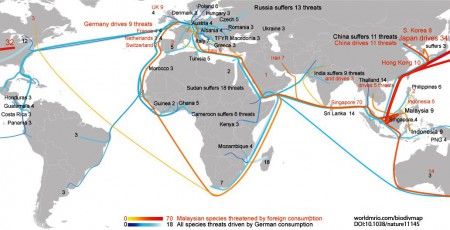- Slate puts a fork in, well, the fork.
- Gotta love the Prairies.
- Mysterious Cattle Deaths Caused by GMO Grass: not GMO, not particularly mysterious.
- Gotta love the Spice Islands.
- How scientists can extract impact from their
navel-gazingresearch. - Gotta love online mapping platforms.
- Another journal starts a blog.
- Horses in agriculture, and history.
- Gotta love za’tar. It’s about thyme.
- Sweeter than sugar. Mauritius goes for fair trade and diversification.
- Dying for batik.
Brainfood: Synthetic wheat, Pisum, Maize products, Seed predation, Cajanus, Tripsacum, Horse domestication, Cicer genomics, Cereal vulnerability, Allotments, Conservation units, Chilie diversity, Endophytes
- Sources of resistance in primary synthetic hexaploid wheat (Triticum aestivum L.) to insect pests: Hessian fly, Russian wheat aphid and Sunn pest in the fertile crescent. Domestication do-over continues to show promise. Closest thing to a jetpack?
- Evaluation of seed yield and seed yield components in red–yellow (Pisum fulvum) and Ethiopian (Pisum abyssinicum) peas. Weird pea species show promise in Serbia, of all places.
- Consumer preferences for maize products in urban Kenya. Most still like it white. Not much promise there.
- Bush pig (Potamochoerus porcus) seed predation of bush mango (Irvingia gabonensis) and other plant species in Democratic Republic of Congo. It’s pretty unpromising for seeds, especially right under the tree.
- Phenotypic diversity in Cajanus species and identification of promising sources for agronomic traits and seed protein content. 14 accessions of 8 seem promising (out of a total of 198 accessions of 18 species from the ICRISAT collection).
- Genetic relations among Tripsacum species revealed by genomic variation. They might be promising.
- Reconstructing the origin and spread of horse domestication in the Eurasian steppe. Wild Equus ferus moves out of eastern Eurasian steppe 160 kya, shows promise, gets domesticated in the western part, but continues to introgress with local wild horses as it moves out from there.
- Large-scale development of cost-effective SNP marker assays for diversity assessment and genetic mapping in chickpea and comparative mapping in legumes. What can I tell you. It’s large-scale. It’s cost effective. It’s promising. I’m still waiting for my jetpack.
- The socioeconomics of food crop production and climate change vulnerability: a global scale quantitative analysis of how grain crops are sensitive to drought. It’s the middle income countries that are especially vulnerable, and thus where all that promise needs to come good.
- Deskilling, agrodiversity, and the seed trade: a view from contemporary British allotments. Please promise to keep open-pollinated heirlooms out of the marketplace.
- Harnessing genomics for delineating conservation units. But you need to combine information from neutral and adaptive markers in fancy ways to fulfill the promise.
- Why are not all chilies hot? A trade-off limits pungency. It’s all about how much water is available.
- Endophytic Insect-Parasitic Fungi Translocate Nitrogen Directly from Insects to Plants. Suppose we better promise to conserve these things too then. And here’s the slightly longer short version.
Nibbles: CWR video, Super barley, Banana fermentation, Cerrado, Indian genebank sell-off farrago, Pistacia, Potato disease
- Al Jazeera discovers wild relatives.
- The Scotsman discovers the laws of heredity.
- Diana uncovers banana beer.
- Rio +20 hacks discover the cerrado.
- Indian genebank discovers the market?
- JSTOR uncovers the pistachio.
- Scottish potato farmers discover new nemesis.
Following threats to animals along supply chains
As Rio +20 looms ever nearer, everyone is scrambling to put stuff out pushing their particular agenda, taking care to note that they’re not suggesting that their agenda is any less vital than anyone else’s agenda, of course, and that in any case There Are No Silver Bullets. One of the more interesting products released to coincide with next week’s Brazilian festivities is an interactive map which uses “a new global trade database to follow the products implicated in species threats right through to the final consumers.”
The paper describing the methodology is in Nature.
We linked 25,000 Animalia species threat records from the IUCN Red List of endangered species to over 15,000 commodities produced in 187 countries. We then used the trade database to evaluate over 5 billion supply chains in terms of their biodiversity impacts.
It’s a massive undertaking, and it may be churlish to wonders why it’s not easier to export the maps it enables one to produce. So I won’t, and merely confine myself to hoping that a plant version will be available soon. Oh, and maybe also one in which agriculture is not seen only as the bad guy. In fact, would it not be nice to have the other side of the coin? That is, a map showing where supply chains may actually be contributing to conservation. Come on, there must be a few examples of that! Bird-friendly coffee, anyone?
Nibbles: Pests & Diseases, Cichorium, Agroforestry etc, Heritage oranges, Shepherds, ITPGRFA news
- Diversity protects against pests and diseases, especially when it is needed most.
- Amateur enthusiast cracks chicory biodiversity.
- Conservation Agriculture With Trees; it’s the new big thing in Africa.
- Saving the last orange grove in Orange County from destruction.
- Shepherds of the world; a slideshow from The Guardian.
- And — Oh Boy! — you can jump through some hoops to get a newsletter on the International Treaty of Plant Genetic Reso0urces for Food and Agriculture.
